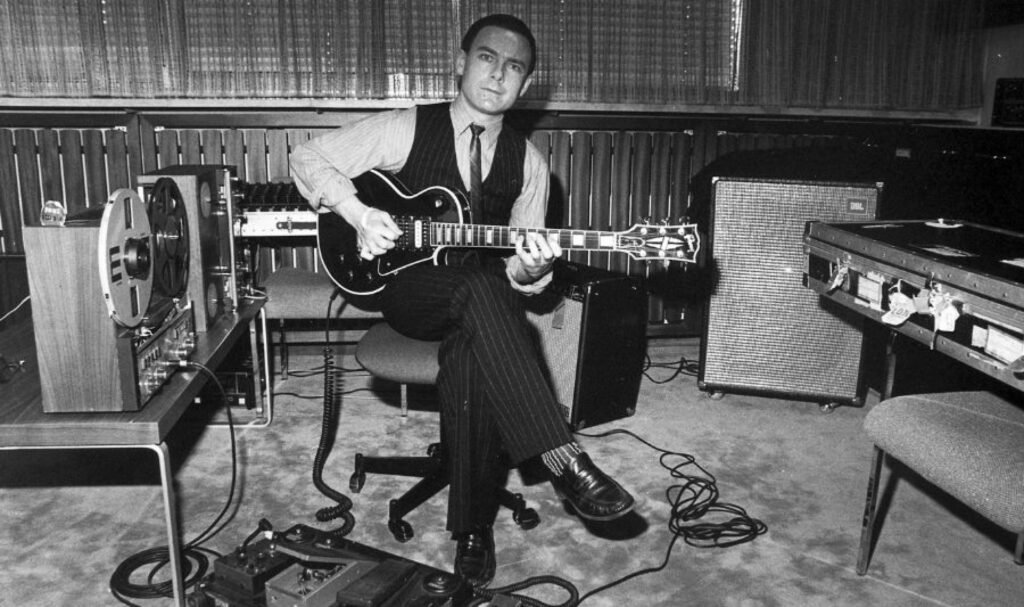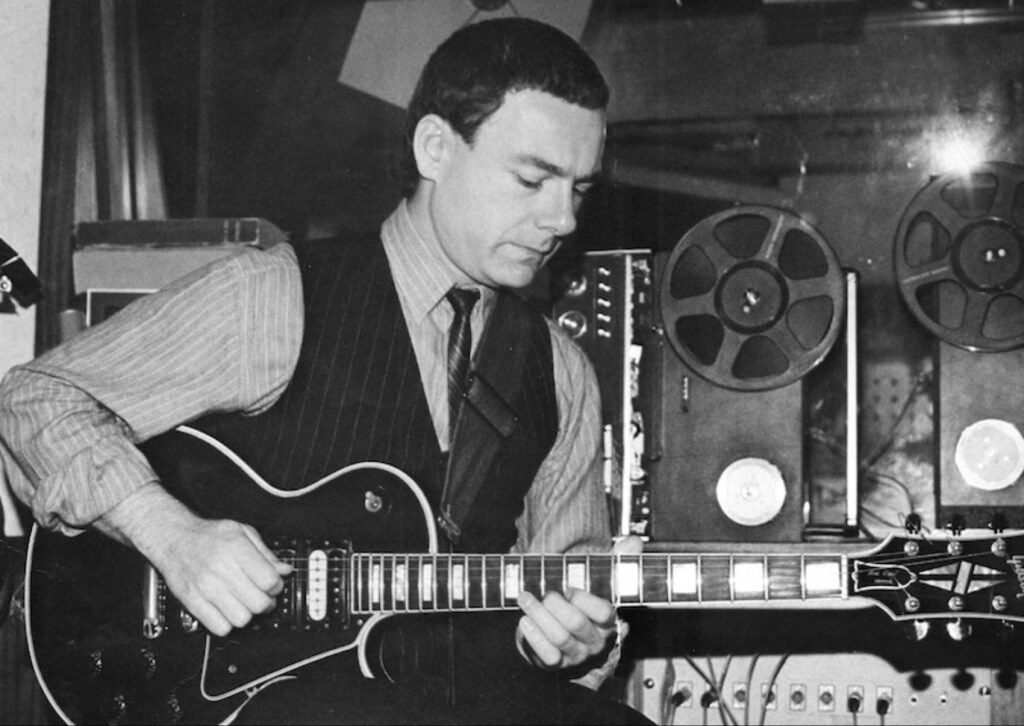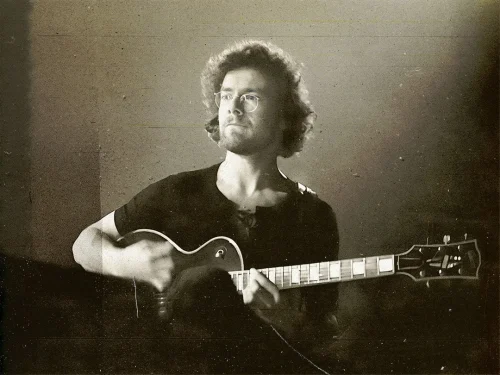Robert Fripp, a towering figure in the progressive rock landscape, is perhaps best known as the founding member and continuous driving force behind the seminal band King Crimson. Since the late 1960s, Fripp’s innovative guitar work, coupled with his theoretical approach to music and sound, has placed him at the forefront of musical experimentation. His contributions to the music industry extend beyond performances, encompassing a broad array of recording techniques and musical philosophies that have influenced countless artists and genres.
Delve into one of Fripp’s most intriguing and influential experimental ventures: the “Frippertronics” era. Characterized by its use of tape loops and delay systems, Frippertronics not only redefined Fripp’s guitar playing but also left an indelible mark on King Crimson’s sound throughout the 1980s and 1990s. We will explore the origins of this technique, its implementation in various musical projects, and how it transformed the auditory landscape of the band, influencing the progression of ambient and experimental music. Through this exploration, we aim to illuminate the depth of Fripp’s impact on the music world, celebrating an era where technology and creativity merged to chart new territories in sound.
Background: Robert Fripp and King Crimson

History
Robert Fripp’s journey into the annals of music legend began in the tranquil setting of Wimborne, Dorset, England, where he was born in 1946. His musical career took a decisive turn in 1969 with the formation of King Crimson, a band that would soon become a cornerstone of the progressive rock genre. The band’s debut album, “In the Court of the Crimson King,” released in the same year, was a watershed in rock music, introducing a complex and layered sound that was unlike anything heard before. This album not only established King Crimson as a seminal force in progressive rock but also spotlighted Fripp as a formidable guitarist and visionary musician.
Musical Influence
King Crimson’s early style was marked by a blend of rock, jazz, classical, and experimental music, reflecting a melting pot of influences that ranged from the Beatles and Jimi Hendrix to the complexities of classical composers and the free-form jazz of the 1960s. The band’s music was characterized by dramatic changes in dynamics, extended instrumental passages, and a penchant for complex rhythms and lyrical themes steeped in mythology and philosophy.
Robert Fripp’s influence on King Crimson was profound. His methodical approach to music, often referred to as “Frippertronics,” involved the use of tape loops and delay systems to create rich, textured soundscapes. This technique allowed Fripp to expand the sonic capabilities of the electric guitar, turning it into an orchestra of sounds that could evoke both vast, serene landscapes and intense, turbulent storms. His vision steered the band through numerous lineup changes and musical evolutions, with each iteration of King Crimson exploring new sounds and ideas while maintaining a core of innovation and complexity.
The Advent of Frippertronics

Definition and Development
Frippertronics is a term coined by Robert Fripp to describe his unique method of creating music using electric guitar, interconnected reel-to-reel tape recorders, and a series of delay effects. The essence of Frippertronics lies in its ability to create a continuous, flowing tape loop that Fripp would play over, allowing layers of sound to build up into rich, textural soundscapes.
This technique involved recording a segment of guitar playing onto a loop of tape which would then pass through the playback head before being fed back into the recording head. The delayed signal, which could be manipulated in terms of speed and feedback, created a loop of sound that could be continually added to or altered, producing a complex, evolving musical piece.
The technical setup typically consisted of two Revox A77 reel-to-reel tape recorders set up so that the tape could travel from the supply reel of the first machine to the take-up reel of the second, allowing for several seconds of delay between the recording and playback heads. This setup not only created an echo effect but also allowed Fripp to layer multiple melodies and harmonies in real time, thus creating a one-man symphony of sound textures that was both innovative and captivating.
Inspiration and Innovation
Robert Fripp’s development of Frippertronics was heavily influenced by his collaboration with Brian Eno, who himself was a pioneer in the realm of ambient music. Eno’s work with tape delay systems in his own ambient projects provided a conceptual framework and technical foundation from which Fripp could explore his own musical ideas. The collaboration between Fripp and Eno on albums such as “(No Pussyfooting)” and “Evening Star” showcased the potential of these ambient soundscapes and served as a laboratory for the development of Frippertronics.
Moreover, Fripp’s interest in tape looping and ambient music was not merely a pursuit of new sounds but also rooted in his philosophical and musical outlook. He was deeply interested in creating a type of music that was immersive and could alter the listener’s perception of time and space, an approach that resonated with Eno’s theories of ambient music as creating an atmosphere or environment through sound.
Implementation and Evolution

Incorporation into Music
The Frippertronics technique was not only a hallmark of Robert Fripp’s solo performances but also became a fundamental element in the evolution of King Crimson’s music. Its integration into the band’s sound can be seen as early as the album “Discipline” (1981), where the influence of minimalism, ambient, and new wave melded with progressive rock to create a sound that was starkly different from the band’s earlier works. The looping, layered textures of Frippertronics brought a new dimension to tracks like “The Sheltering Sky,” which utilized tape loops to create a mesmerizing, atmospheric backdrop that complemented the intricate guitar and percussion patterns.
In Fripp’s solo projects, the use of Frippertronics was even more pronounced. Albums such as “Exposure” (1979) and “Let the Power Fall” (1981) are exemplary in showcasing how Frippertronics could be the centerpiece of musical compositions. On “Let the Power Fall,” Fripp used looping tape delays to create complex, evolving layers of sound, allowing the guitar to transcend traditional roles and become a source of ambient, almost orchestral music.
Evolution Over Time
Throughout the 1980s and 1990s, Frippertronics continued to evolve and influence the direction of King Crimson’s music. By the time of the albums “THRAK” (1995) and “The ConstruKction of Light” (2000), the original Frippertronics concept had morphed into what Fripp called “Soundscapes.” This new iteration was enhanced by digital technology, which allowed Fripp to create deeper, more complex layers of sound and manipulate them with greater precision.
Key tracks that highlight this evolution include “VROOOM VROOOM,” where the Soundscapes technique contributes to the dense, textured sound that characterizes much of King Crimson’s later work. In his solo performances during this period, Fripp would often create live Soundscapes, using digital equipment to generate real-time audio loops and layer them into lush, expansive sound fields, offering audiences a deeply immersive listening experience.
Impact on King Crimson’s Sound in the ’80s and ’90s

Sound Transformation
The introduction of Frippertronics significantly altered King Crimson’s musical direction, marking a distinct phase in the band’s evolution. This era saw a shift from the dense, heavily orchestrated textures of their early years to a more minimalistic, rhythmically complex approach that integrated ambient and electronic elements. The method allowed the band to experiment with creating expansive soundscapes that could serve as both foreground and background, giving their music a more atmospheric quality. This shift is particularly evident in the way the band used space and silence, elements that became as integral to their compositions as the notes themselves.
The Frippertronics influence is perhaps most evident in the way King Crimson’s guitar work evolved. Fripp’s loops and delays transformed the guitar from a traditional rock instrument into a versatile tool for generating sonic landscapes, influencing not only his own parts but also how other band members interacted within the compositions. The rhythmic interplay, particularly with the Stick and percussive elements, was tailored to complement these textured layers, creating a sound that was as much about groove and pattern as it was about melody.
Albums and Critical Reception
During the ’80s and ’90s, several key albums highlighted the impact of Frippertronics on King Crimson’s sound. “Discipline” (1981), “Beat” (1982), and “Three of a Perfect Pair” (1984) collectively known as the ’80s trilogy, showcase the integration of Frippertronics into a more structured song format. “Discipline,” especially, was critically acclaimed for its innovative use of overlapping rhythmic patterns and tonal textures, which were a direct outcome of Frippertronics techniques. The track “Elephant Talk,” for example, features interlocking guitar parts that are characteristic of the Frippertronics influence, creating a sound that was entirely new for King Crimson.
In the 1990s, the album “THRAK” (1995) further exemplified the evolution of Frippertronics into what Fripp termed Soundscapes. The album received favorable reviews for its innovative approach and the way it seamlessly integrated electronic and acoustic elements. The sound was denser and more orchestral than in previous works, but still retained the ambient, layered textures that Frippertronics had introduced. Tracks like “Dinosaur” and “VROOOM VROOOM” not only reflect this denser sound but also demonstrate how the band’s experimental ethos had matured, incorporating both the complexity of their early years with the minimalism introduced by Frippertronics.
Legacy and Influence

Influence on Other Musicians
The advent of Frippertronics not only marked a significant point in the evolution of King Crimson’s music but also left a lasting imprint on the broader music landscape. Robert Fripp’s innovations with tape looping and delay effects significantly influenced the development of ambient music, experimental rock, and even the burgeoning electronic genres of the 1980s and 1990s. Artists and bands across a spectrum of musical styles have cited Fripp’s techniques as a key influence in their work, appreciating the way his methods expanded the possibilities of sound creation and manipulation.
In the realm of ambient music, Brian Eno’s collaborations with Fripp provided foundational works that many ambient musicians regard as pivotal. Beyond Eno, artists like the Orb and Moby have integrated similar textures into their electronic compositions, often acknowledging the influence of Frippertronics on their sound. In the experimental rock and post-rock genres, bands such as Radiohead and Sigur Rós have similarly employed looping and layering techniques reminiscent of Fripp’s, using them to create atmospheric and emotionally resonant music that pushes the boundaries of conventional rock.
Technological and Musical Legacy
Robert Fripp’s approach to music production, particularly his use of technology to redefine the role of the guitar and the studio in live performance, has had profound implications for the music industry. The legacy of Frippertronics can be seen in the widespread adoption of digital looping devices and software, which are now commonplace in both studio and live settings. This democratization of music production tools has allowed musicians of all levels to experiment with layered sounds and complex arrangements that were once only possible with professional studio equipment.
Furthermore, Fripp’s work has encouraged a more exploratory approach to music making, where the process of creating sound is as important as the sound itself. This philosophy has permeated various music education programs and has inspired a generation of musicians to experiment with sound as a malleable and expressive medium.
The influence of Frippertronics extends into the way music interacts with other media. The technique’s ability to create evocative soundscapes has made it a valuable tool in film, television, and multimedia art, where atmospheric sound is crucial in shaping emotional and narrative contexts.
Robert Fripp’s exploration of the interplay between technology, music, and expression has left a lasting impact, ensuring his place as a pioneer whose contributions continue to resonate across musical and artistic landscapes. This legacy of innovation and exploration stands as a testament to his vision and creativity, inspiring musicians and listeners alike to reimagine the possibilities of sound.
